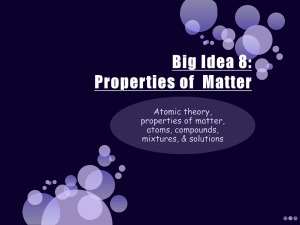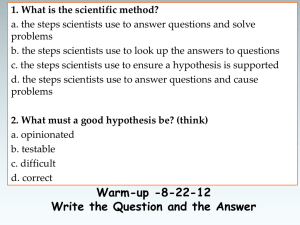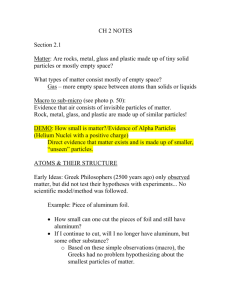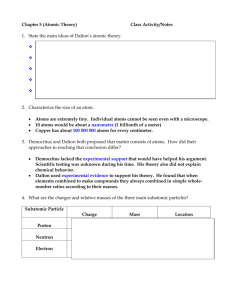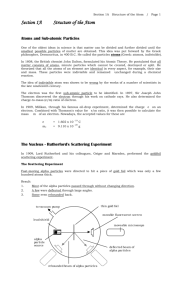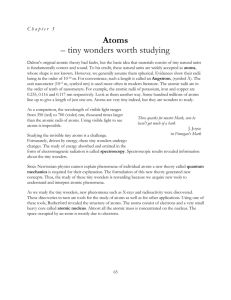Study Guide ch1 Atomic Structure History
advertisement
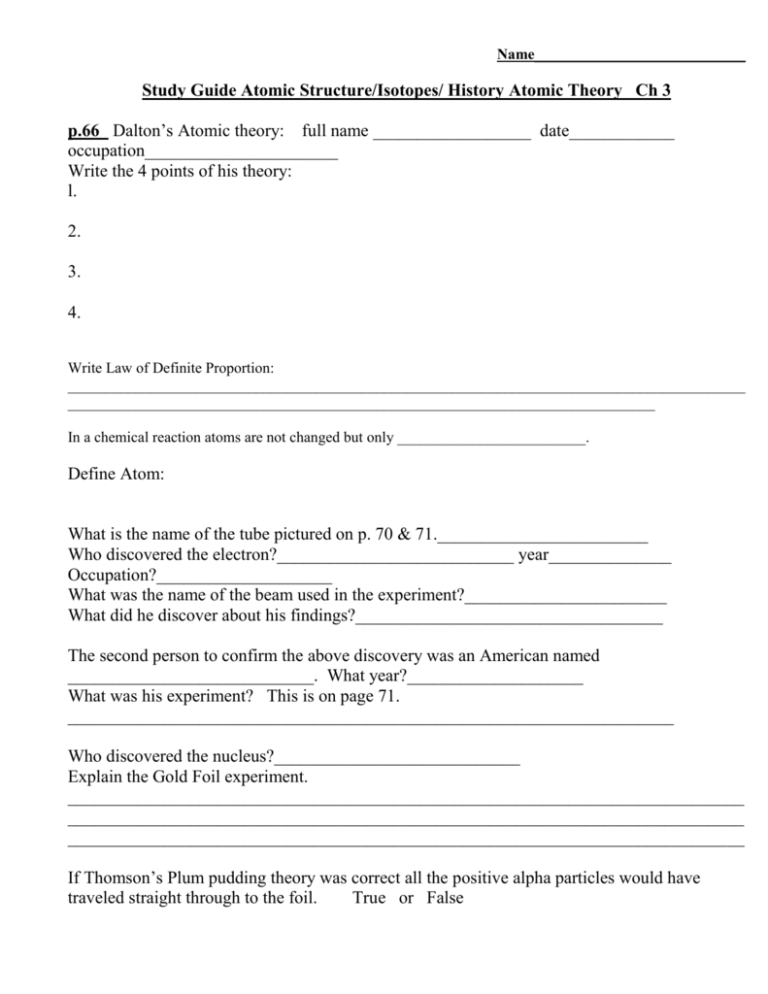
Name____________________________ Study Guide Atomic Structure/Isotopes/ History Atomic Theory Ch 3 p.66 Dalton’s Atomic theory: full name __________________ date____________ occupation______________________ Write the 4 points of his theory: l. 2. 3. 4. Write Law of Definite Proportion: __________________________________________________________________________________________ ______________________________________________________________________________ In a chemical reaction atoms are not changed but only _________________________. Define Atom: What is the name of the tube pictured on p. 70 & 71.________________________ Who discovered the electron?___________________________ year______________ Occupation?____________________ What was the name of the beam used in the experiment?_______________________ What did he discover about his findings?___________________________________ The second person to confirm the above discovery was an American named ____________________________. What year?____________________ What was his experiment? This is on page 71. _____________________________________________________________________ Who discovered the nucleus?____________________________ Explain the Gold Foil experiment. _____________________________________________________________________________ _____________________________________________________________________________ _____________________________________________________________________________ If Thomson’s Plum pudding theory was correct all the positive alpha particles would have traveled straight through to the foil. True or False What happened in the experiment that totally shocked Rutherford? _____________________________________________________________________________ _____________________________________________________________________________ List Rutherford’s two conclusions about the atoms. __________________________________________________________________________________________ __________________________________________________________________________________________ Who discovered the neutron?________________________________year_____________________ Write 3 interesting items about this man. “not in book google” __________________________________________________________________________________________ __________________________________________________________________________________________ Define: Atom: Element: Compound: Can you tell the difference between an element and a compound? …. Circle all elements. H20 Na KClO3 CO2 O2 H2SO4 HCl Fe K Ca Three Subatomic particles: Proton: Location: Charge Mass: Neutron: Location: Charge Mass: Electron: Location: Charge: Mass Counting Atoms What does the atomic number tell?_____________________________ Where is it located?__________________ What does Atomic mass tell?__________________________________ Where is it located?__________________ All atoms of a given element have the same number of ___________ or same atomic number. If the atomic number or number of ________________ changes, the element changes. If atoms are electrically neutral, the number of electrons equals the atomic _____________. KNO3 Fill in the following atomic chart Symbol Name Atomic# Atomic Mass #p #e #n Cu______________________________________________________________________________ Mg______________________________________________________________________________ O________________________________________________________________________________ Au______________________________________________________________________________ Define Isotopes: ____________________________________________________________________________ The isotopes of a particular element all have the same number of protons and electrons but different number of __________________________. Isotopes do not differ significantly in their chemical behavior. l. How many protons, electrons, neutrons in an atom of 2. Write Nuclear Symbol for Carbon-13. 3. Write Hyphen Notation for element with 15 electrons, 15 neutrons . 4. Write nuclear Symbol for aluminum. 5. Write the Hphpen Notation for element with 48 protons and 88 neutrons. Isotopes are used extensively in what field of Science? ________________________________________ Define Ion: __________________________________________________________________________ Any process that results in the formation of an ion is referred to as _______________________________ Ions have the ability conduct __________________________because of their positive and negative poles. If an element loses an electron it becomes __________________________ . It is called _____________ . All metals are ___________________. If a metal loses an electron it is oxidized. OIL =______________________________________________ If an element gains an electron it becomes _____________________ . It is called __________________ . If a non-metal gains an electron it is reduced. RIG =___________________________________________ Write the symbol for the following elements that have lost the following electrons: Sodium lost one electron____________ Calcium lost two electrons____________ Aluminum lost three electrons_______________________ Chlorine gained one electron____________ Sulfur gained two electrons_________________ Phosphorus gained three electrons__________________ Same question that can be asked four different ways. “Critical Thinking...not just memorize” 1. Which conclusion is based on the “gold foil experiment” and the resulting model of the atom? A. An atom is mainly empty space, and the nucleus has a positive charge. B. An atom is mainly empty space, and the nucleus has a negative charge. C. An atom has hardly any empty space, and the nucleus has a positive charge. D. An atom has hardly any empty space, and the nucleus has a negative charge. 2. Subatomic particles can usually pass undeflected through an atom because the volume of an atom is composed of: A. an uncharged nucleus B. largely empty space C. neutrons D. protons 3. In Rutherford’s gold foil experiments, some alpha particles were deflected from their original paths but most passed through the foil with no deflection. Which statement about gold atoms is supported by these experimental observations? A. Gold atoms consist mostly of empty space. B. Gold atoms are similar to alpha particles. C. Alpha particles and gold nuclei have opposite charges. D. Alpha particles are more dense than gold atoms. 4. An experiment in which alpha particles were used to bombard thin sheets of gold foil led to the conclusion that an atom is composed mostly of: A. empty space and has a small, negatively charge nucleus B. empty space and has a small, positively charge nucleus C. a large, dense, positively charged nucleus D. a large, dense, negatively charged nucleus Neils Bohr was responsible for the Modern Atomic Theory of electrons and energy levels. Define: ground state atom: Excited state atom: What is light made of:______________________________________ Explain what light does to an electron. __________________________________________________________________________________________ ______________________________________________________________________________ Explain what happens when an electron falls back to a lower energy level. __________________________________________________________________________________________ _____________________________________________________________________________





